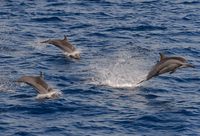Marine Wildlife UK
Sailing in UK oceans can be an absolute delight, and when you are around particularly wildlife surrounded areas such as North Wales, Scotland or England's many quiet seaside locations, it will please you to know that there is an abundance of wildlife.
Eyes on the waters!
If you’re out for a cruise in your Jeanneau yacht, you may just be surprised by the various aquatic shapes to be seen darting through the water. Having your own yacht provides you with an advantageous viewpoint from which to view marine wildlife then something which the general public have access to. It means you can sail out to wildlife havens and have a base of operations, as well as a viewing platform. You would be the envy of many of wildlife enthusiast landlubbers.
Taking your vessel out upon the surrounding oceans of the United Kingdom could yield some truly amazing sightings.
Here are a few sea-creatures you might just catch a glimpse of, looking over the prow of your vessel.
Basking Shark
The word Shark seems to raise panic in any seafarer, however, you have nothing to fear from this fella. While this creature is the second largest species of fish alive today. The Basking Shark uses its massive cavernous jaw only to feed on microscopic plankton, and its digestive system is totally unsuitable to eat anything larger. Nevertheless, these hulking leviathans make a fantastic sight to behold.
You’re more likely to spot this species in the summer, as its name ‘basking shark’ comes from the fact it is most often observed when basking in the warmer waters of the surface, thought to overwinter in deep waters. It’s also known as the ‘Sun-Fish’ if you prefer that, somewhat less threatening term!

Basking Shark UK
Seals
You might just spot Common or Grey Seals playing or hunting. You can tell which are which, as grey seals are larger growing to 2.5 metres, and have an elongated nose, with nostrils, which run parallel. Common Seals, on the other hand have ‘V’ shaped nostrils.

Common Seal

Grey Seal
Harbour Porpoise
You can tell these apart from dolphins by the shape of their heads, lacking a prominent peak unlike their cousins. These can mostly be found in inshore waters, likely sighted in bays and inlets. When they surface from under the water their expulsion of water can often be heard but not seen, with a loud blowing sound, earning them the nickname of ‘puffing pig’

Harbour Porpoise swimming in British Waters
Dolphin
Dolphins such as the Bottlenose and Common Dolphin can be found throughout the isles, particularly in Scottish waters. What gives away their presence is schools of them splashing and leaping which can be seen and heard from leagues away. The shape of their heads also give them away, with a prominent beak, which helps to tell them apart from Porpoises. You can tell the bottlenose apart from the common species by looking at the colouring, Common Dolphins have a distinctive creamy hourglass pattern on the side, while bottlenose dolphins have a dark grey back.

Bottlenose Dolphin
Orca ‘Killer Whale’
Subject of many popular modern documentaries, these apex predators have their name for a good reason. Being top of the food chain they don’t have any natural predators, and therefore pretty much have their run of the ocean when it comes to feeding. The size and colouring of these make them pretty distinguishable; look out for their distinct jet-black body and white underside, side and eye patches. Also look out for their large dorsal fin, which is larger than any other cetacean.

Killer Whales
There are many more species of ocean mammals and fish to be found around the British isles, but there are a few to look out for on your sea-cruises. You will often find that spotting a rare creature might just make your whole trip!
If you are without a boat why not look into Yacht Charter?
Image Credit: Alessandro Caproni - Dolphins - Creative Commons 2.0 |







